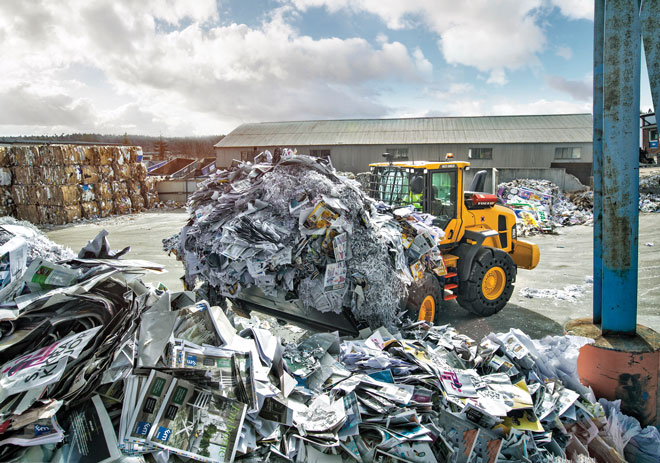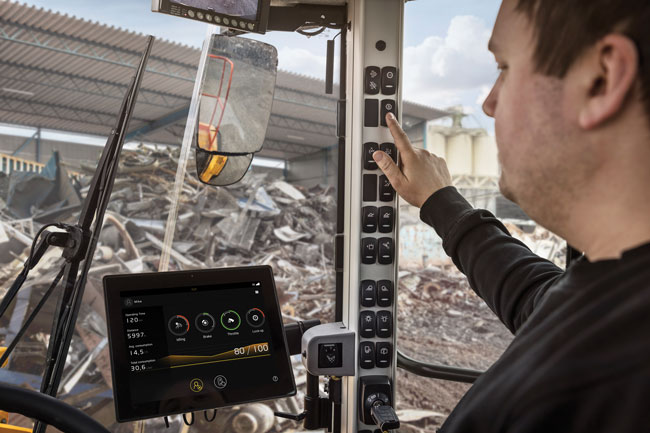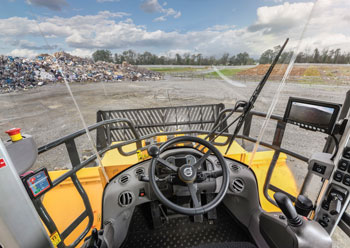Using data in regular telematics reports can show a fleet manager exactly how each machine is being used, identifying which ones are underused and could be reallocated to another site.
By Todd Cannegieter
Landfill equipment faces some of the harshest abuse of any application and can require more attention from fleet managers or mechanics as a result. If your landfill fleet is not using telematics to their full potential yet, it may be time to reconsider that choice.

Part of the problem is that too many telematics systems put the burden on the equipment owner to sift through lots of data and figure out what the problem is, and they do not provide any insights to spot trends or make data-based decisions. Advanced, OEM-managed telematics programs can provide streamlined remote diagnostics with specific recommendations and in-depth fleet use reports.
Here are four of the top ways partnering with an OEM and/or equipment dealer on a managed telematics program can help simplify your work and ultimately improve a fleet’s profitability.

#1: Cut Through the Clutter
Standard telematics systems alert the user for every machine fault code, no matter how critical or noncritical. For instance, a fleet manager overseeing a combination of 30 landfill compactors, wheel loaders, dozers and articulated haulers might get five to 10 e-mails or texts per day with noncritical fault codes such as low windshield wiper fluid. Only a small percentage might be something that could lead to a critical issue if not acted upon quickly.
With a cluttered inbox of easily ignored noncritical alerts, the likelihood of occasionally overlooking something important is pretty high—potentially leading to downtime that could have been avoided.
Also, the alerts from standard telematics systems typically only let the fleet manager know what fault code went off, rather than offering a probable cause and a recommended solution. That means the fleet manager is ultimately responsible for diagnosing the problem and figuring out what to do about it.
OEMs and equipment dealers recognize that data overload is a challenge to telematics adoption. Some offer to help sort through the clutter of machine fault codes, only alerting the fleet manager when it is critical in nature. For example, monitoring systems can alert the dealer and fleet manager with information on the likely cause of a critical fault code, the recommended solution and the potential consequences if not acted upon.
Using this type of program allows landfill fleet managers to react to critical situations faster and more accurately, thereby avoiding costly downtime and avoidable repair costs. It also helps the equipment dealer know exactly what tools and technicians to send if a repair is necessary, in turn, reducing the number of trips for which the fleet manager has to pay.

#2: Reduce Idle Times
Many operators have a tendency to idle their machines when not in use, rather than shutting them down. A machine’s use rate (idle versus work percentage) can have a big impact on both resale value and maintenance costs.
Whereas a standard telematics system might bury this information within a mountain of data that the fleet manager must sort through to draw conclusions, telematics monitoring systems, in which a dealer or OEM provide this information concisely on a regular basis, can help set goals for idle time reductions.
Imagine two of the exact same compactors doing the same work on the same site—Machine A runs at 50 percent idle time and Machine B at 33 percent. Let’s say Machine A runs about 2,000 hours each year and Machine B runs about 1,500. After five years, Machine A has accumulated 10,000 hours and Machine B has 7,500. That would be a difference of five 500-hour service intervals, which adds up quickly. It would also make a huge difference in the amount of fuel burned, which is why some machines have an auto idle shutdown feature. Reduced idle hours should also increase Machine B’s resale value.
#3: Spot and Correct Instances of Machine Misuse
The wear and tear on a machine and its corresponding lifespan are largely in the hands of the operator. What may seem like insignificant behaviors can add up to significant operating cost increases.
With standard telematics systems, operator behavior data—if available at all—often requires some digging to draw conclusions.
Common landfill machine misuse issues that can be flagged with the help of an OEM- or dealer-based telematics system include:
- Hot turbo shutdowns, which can eventually lead to turbocharger damage or failure
- High-speed shifts on wheel loaders, which can lead to transmission damage
- Misuse of excavator work modes, which can lead to elevated fuel usage
- Cycles with overloaded haulers, which can damage haul roads and shorten tire life
An advanced telematics system that flags instances of machine misuse allows a fleet manager to more easily identify which operators could benefit from training to reduce wear and tear, as well as overall operating costs.

#4: Maximize Fleet Use
Using data in regular telematics reports can show a fleet manager exactly how each machine is being used, identifying which ones are underused and could be reallocated to another site.
Through OEM- or dealer-generated reports, the fleet manager can also compare model statistics that provide fuel usage and machine hours for each machine during a particular time period, ensuring you will be able to more accurately project fuel costs, planned maintenance intervals and labor.
An OEM knows the ins and outs of the equipment they produce better than anyone. By partnering with them, fleet managers can benefit from their insider knowledge, extensive experience and valuable insights gleaned from a user’s specific telematics data.
Furthermore, an OEM will already have the resources in place to sift through the data to help optimize a jobsite. This removes the burden from fleet managers to either train their existing employees or hire a dedicated staff member to get the best value from their telematics system. Do not be afraid to ask your dealer or OEM about maximizing your use of telematics. It can save you major headaches—and dollars—down the road. | WA
Todd Cannegieter is Product Manager, Attachments and Special Applications for Volvo Construction Equipment. He’s been with Volvo since 2013, working his way up via engineering roles. Todd holds a bachelor’s degree from Iowa State University in mechanical engineering and has more than 16 years’ experience. He can be reached at [email protected].
Volvo’s telematics system, CareTrack, is standard on most equipment. ActiveCare Direct, their 24/7 monitoring service, is a valuable add-on that simplifies upkeep and performance as described in the article.
